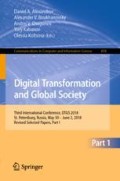Abstract
At present, a large number of information systems have been created that operate productively and provide information support of specific functions. Currently, a topical issue is to unite these information systems, create favourable conditions for their information interaction. This task is particularly important for the creation of an information infrastructure in the electronic government, which involves both large-scale state systems and applications automating local functions. The main part of system interoperability is defined by semantics – tools for transfer of meaningful data, information. Semantics in information space is defined by two components: identification of objects and NameSpace.
In different information spaces the problem of semantics provision is solved in a customized way. In semantic web, it is possible to use standard NameSpaces, or create your own one. An automatically generated URI is used as identifiers.
There are alternative options to reproduce semantics in the framework of information infrastructure. In practice, there are cases where identifiers are a profound business key containing information about individual elements of business logic, the result of which is the object described. The article describes examples of such practice and shows elements of the methodology for creating such identifiers.
The second semantics element is the namespace. In this field, serious groundwork has been made in different economy sectors. There is a tendency of interaction between separate dictionaries and development of uniform approaches. This can be implemented through creation of templates.
Currently, the prerequisites for combination of two elements of semantics definition are fulfilled: identifiers and namespaces. This would make it possible to move quickly towards the creation of an e-government information infrastructure.
Access this chapter
Tax calculation will be finalised at checkout
Purchases are for personal use only
References
ISO 9000 - Quality management. https://www.iso.org/ru/iso-9001-quality-management.html
Maali, F., Cyganiak, R., Peristeras, V.: A publishing pipeline for linked government data. In: Simperl, E., Cimiano, P., Polleres, A., Corcho, O., Presutti, V. (eds.) ESWC 2012. LNCS, vol. 7295, pp. 778–792. Springer, Heidelberg (2012). https://doi.org/10.1007/978-3-642-30284-8_59
Maali, F., Cyganiak, R., Peristeras, V.: Enabling interoperability of government data catalogues. In: Wimmer, Maria A., Chappelet, J.-L., Janssen, M., Scholl, Hans J. (eds.) EGOV 2010. LNCS, vol. 6228, pp. 339–350. Springer, Heidelberg (2010). https://doi.org/10.1007/978-3-642-14799-9_29
Koumenides, C., Salvadores, M., Alani H., Shadbol, N.: Global integration of public sector information. In: Web Science Conference, Raleigh, North Carolina (2010)
Omitola, T., et al.: Put in your postcode, out comes the data: a case study. In: Aroyo, L., et al. (eds.) ESWC 2010. LNCS, vol. 6088, pp. 318–332. Springer, Heidelberg (2010). https://doi.org/10.1007/978-3-642-13486-9_22
National Information Exchange Model. https://www.niem.gov
CAM XML validation. http://www.verifyxml.org/OpenXDX-page.html
Olive, A.: Conceptual Modeling of Information Systems. Springer, Heidelberg (2007)
Wieringa, R.: Real-world semantics of conceptual models. In: Kaschek, R., Delcambre, L. (eds.) The Evolution of Conceptual Modeling. LNCS, vol. 6520, pp. 1–20. Springer, Heidelberg (2011). https://doi.org/10.1007/978-3-642-17505-3_1
Fenna, D.W.J.: A comprehensive codification for the medical hospital information system. Med. Inform. 10, 1 (1985). https://doi.org/10.3109/14639238509010024
HL7 Code Systems. www.hl7.org
Arms, W.: Digital Libraries. M.I.T. Press, Boston (2000)
Lipuntsov, Y.: Application of information model of interagency data-exchange for the aggregation and analysis of stock market data. In: XI International Scientific-Practical Conference Modern Information Technologies and IT-Education SITITO 2016, Aachen (2016)
Group Moscow Stock Exchange. http://www.moex.com
Financial Instrument Global Identifier. http://www.omg.org/spec/FIGI/
IATA Codes. http://www.iata.org/services/Pages/codes.aspx
IMO Identification Number. http://www.imonumbers.lrfairplay.com
Identification of Fixed Objects in Public Transport. www.transmodel-cen.eu/standards/ifopt
The Legal Entity Identifier Regulatory Oversight Committee. https://www.leiroc.org/
Financial services – Legal Entity Identifier. https://www.iso.org/standard/59771.html
ISO/TC 68 Financial services. https://www.iso.org/committee/49650.html
GS1 Global Traceability Standard GS1’s framework for the design of interoperable traceability systems for supply chains. https://www.gs1.org/standards/traceability/traceability/1-3-0
Grassi, P., Garcia M.E., Fenton, J.L.: Digital Identity Guidelines. NIST Special Publication 800-63-3. https://dx.doi.org/10.6028/NIST.SP.800-63-3
ISO 9735:1988 Electronic data interchange for administration, commerce and transport (EDIFACT). https://www.iso.org/standard/17592.html
Core Components Library UN/ CCL for trade. https://www.unece.org/?id=3133
buildingSMART International Standards. https://www.buildingsmart.org/standards
Open Symbology. https://www.openfigi.com/
ISO 16739:2013 Industry Foundation Classes (IFC) for data sharing in the construction and facility management industries. https://www.iso.org/standard/51622.html
Building information models – Information delivery manual. ISO/TC 59/SC 13 Organization of information about construction works. https://www.iso.org/committee/49180.html
ISO 12006-3:2007 Building construction – Organization of information about construction works – Part 3: Framework for object-oriented information. https://www.iso.org/standard/38706.html
RailTopoModel. http://www.railtopomodel.org/en/
Collaboration between RailTopoModel, railML.org and IFC. https://www.buildingsmart.org/collaboration-railtopomodel-railml-org-ifc/
Augele, V.: Comparative Analysis of Building Information Modelling (BIM) and RailTopoModel/railML in View of their Application to Operationally Relevant. In: 8th RailTopoModel Conference, Paris (2017)
Author information
Authors and Affiliations
Corresponding author
Editor information
Editors and Affiliations
Rights and permissions
Copyright information
© 2018 Springer Nature Switzerland AG
About this paper
Cite this paper
Lipuntsov, Y.P. (2018). Identifier and NameSpaces as Parts of Semantics for e-Government Environment. In: Alexandrov, D., Boukhanovsky, A., Chugunov, A., Kabanov, Y., Koltsova, O. (eds) Digital Transformation and Global Society. DTGS 2018. Communications in Computer and Information Science, vol 858. Springer, Cham. https://doi.org/10.1007/978-3-030-02843-5_7
Download citation
DOI: https://doi.org/10.1007/978-3-030-02843-5_7
Published:
Publisher Name: Springer, Cham
Print ISBN: 978-3-030-02842-8
Online ISBN: 978-3-030-02843-5
eBook Packages: Computer ScienceComputer Science (R0)

